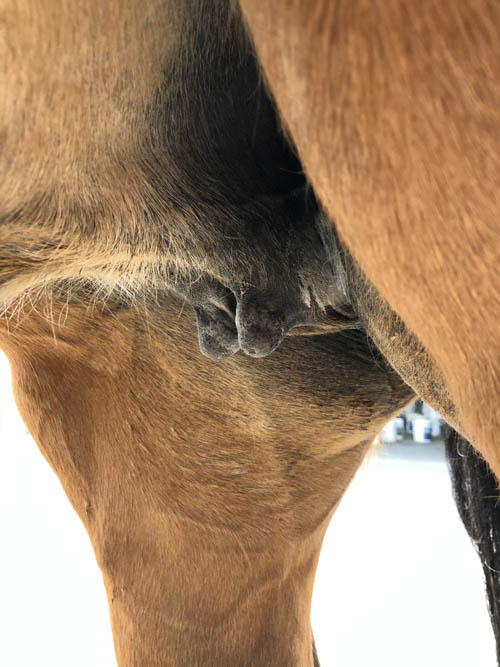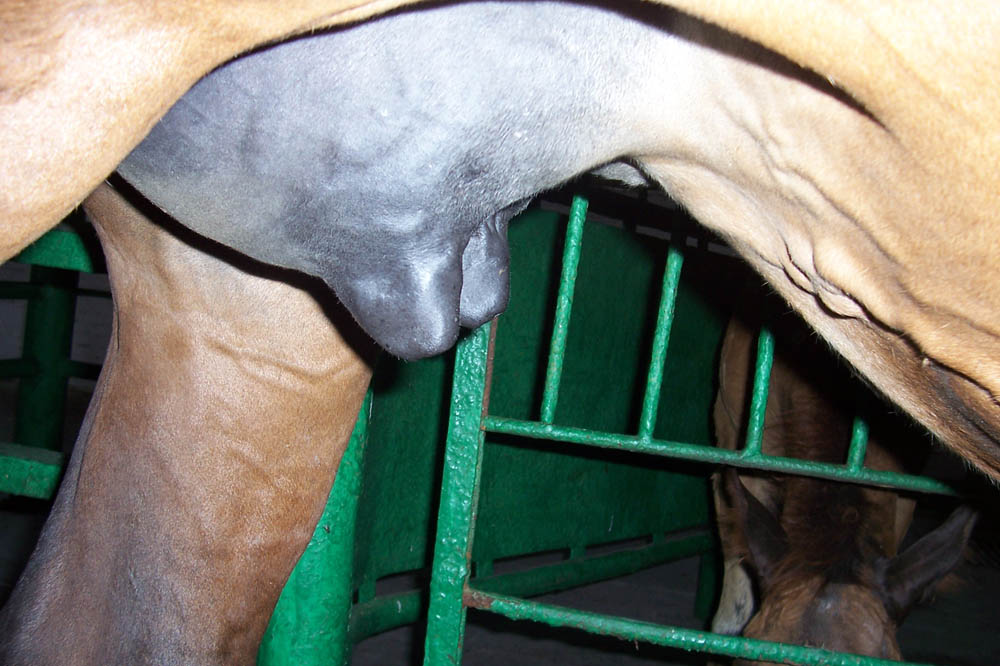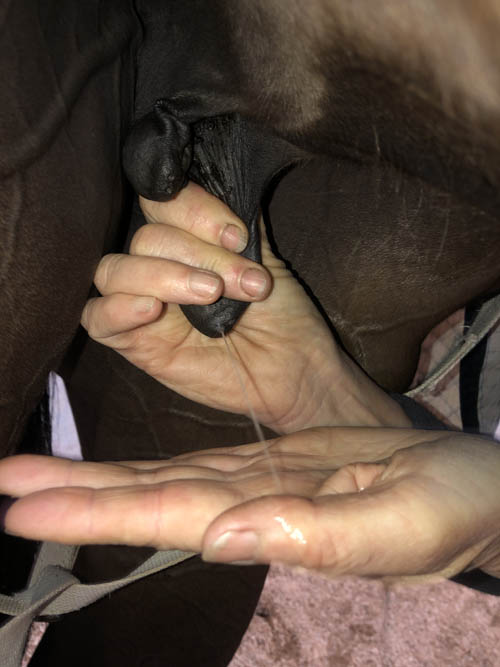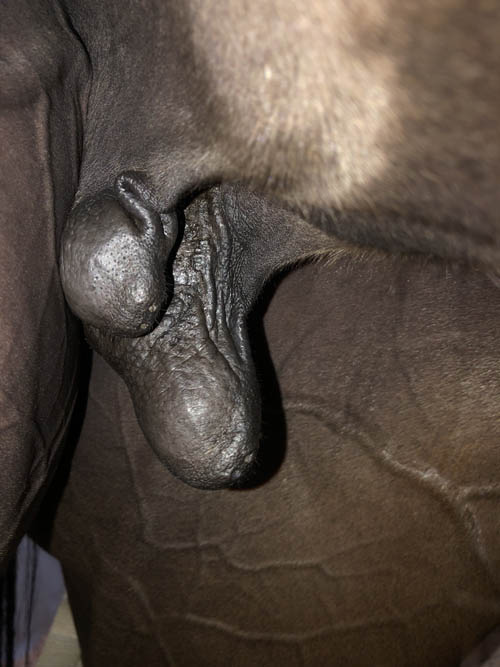Mammary glands are not something we deal with often but they do require medical attention on occasion, and should always be checked during pregnancy, lactation and as part of a pre-purchase examination if the mare or filly is to be purchased for breeding.

A mare’s udder is not something we look at much. In most maiden mares, the mammary gland is tiny and sits up high between the back legs so that to observe it, we need to bend down and look up. In mares that have foaled, it is usually much easier to see the udder as it is so much larger, and even if no longer lactating, the gland will remain significantly larger than a maiden udder.
The most common ailment we deal with would be mastitis, an infection or inflammation of the gland. However, there are other health concerns that can affect the udder and require veterinary intervention, particularly in the diagnosis of unusual swellings in the mammary gland such as tumours and traumatic injuries, or in some cases, examined due to a lack of milk production.
A normal mammary gland is composed of two halves, divided in the midline to give a left and right (“near” and “off”) side. Within each side there is typically a cranial (front) and a caudal (back) part, with the cranial area of the gland being the larger of the two. Each quarter of the udder acts independently of the other, although the milk produced is expressed out of the one teat on each of the sides. If you look at a teat carefully, you will see that there are typically two orifices, a cranial and a caudal, although in some cases three orifices are present due to there being three separate regions within each side. These holes are easily defined when the mare is milked manually as the milk comes out in two (or three, in some cases) streams. It is important to realise this compartmental aspect of the udder, as often when there is a problem within the gland, it is only one or two areas that are affected, and treatment needs to be directed toward the affected side.
As mentioned earlier, mastitis is the most common problem with udders that we deal with in mares. Mastitis is often caused by a bacterial infection, although it can occur because of fungal or parasite invasion. There are several ways that bacteria can gain access into the udder, the more common one being up through the teat into the gland. Bacteria can also be deposited by penetrating wounds into the mammary gland or less frequently via the bloodstream. Local defence systems within the udder usually prevent infections occurring, but in circumstances where the defence systems are compromised, or the invading bacteria are particularly virulent, the infection can take hold.
ENLARGED
Mares suffering with mastitis usually show an enlarged, hot and painful udder on one or both sides. The mare may show signs of hindlimb lameness, especially if one side is markedly sore and painful. Careful palpation may show that only the cranial or caudal area of the gland is involved, but this is more difficult to access for the inexperienced handler as the mare will often not like anyone touching her and kick violently if handling the udder is attempted. If fluid is expressed from the udder, it is often discoloured or thick and lumpy and can sometimes appear blood-tinged. Some mares can become systemically ill with mastitis, with toxins from the udder circulating in the blood causing a fever and lethargy.
As one of the main defences to protect the udder from infection is milk flushing out any bacteria that ascends through the teat, a mare that is no longer feeding her foal is especially vulnerable to mastitis. Mares that have recently weaned a foal, or mares whose foals are not drinking or have recently died, should be checked several times as this is a high-risk group with the milk sitting stagnant in the udder.
It is important to point out that following weaning, or the death of a foal, a mare’s udder will be engorged with milk and will swell and be mildly painful as the mare continues to produce milk until there is negative feedback on the udder to say milk production is no longer required. Once the stimulus for milk production is gone (no suckling), the udder becomes distended, and the message is sent back to turn off the lacteal cells that are producing milk. This swelling subsides over a week or two and the mare shows no evidence of an infection (temperature, off feed, depressed). If fluid is expressed from the teat, it will look like milk and not be an abnormal colour or consistency as seen with mastitis.
Whilst the urge to milk the mare to relieve any discomfort is often felt by owners, it is important not to do this, as milking the mare will stimulate the production of more milk. Occasionally in very engorged udders I will milk out a very small amount just to reduce some pressure, but still leave the udder distended enough that the negative feedback to the udder that milk is no longer required occurs.


TREATMENT
Treatment for mastitis is usually centred on antibiotics and anti-inflammatory medications. A milk sample should be taken prior to treatment, and this is cultured to identify the offending bacteria and the antibiotic of choice to deal with the infection. Antibiotics can be given systemically or can be infused into the udder directly via the teat orifice. The antibiotic preparations made for mastitis in cows are commonly used for mares, but the nozzle should not be forced too far up into the teat canal as the nozzle of the syringe is designed for cow teats, which are larger and longer than most mare teats. Occasionally, if the mastitis is not treated or does not respond to treatment, an abscess can form, requiring more aggressive treatment such as surgical drainage. Complications can occur resulting in scarring and loss of use of the lobe or lobes involved in the infection.
“Inappropriate lactation” is the term used to describe the early development of an udder in young fillies or mares that have never been breeding. The filly or maiden mare will develop an enlarged udder and a milky secretion can be expressed form the teat if milked. This is related to extrinsic hormonal factors (phytoestrogens), often dietary-related, that interact with the female’s circulating hormones and induce lactation. Most of these horses will spontaneously settle but the udder should be checked periodically as mastitis can occur and require treatment.
It should be noted that these fillies or young mares will retain an enlarged udder and never return to the small indistinct organ, so owners should not be concerned if their filly’s udder is different to the normal indiscreet gland, provided there is no evidence of heat, pain or unusual swelling.
Some medications that are used in other species to dry off the milk have been tried in mares to stop the milk production, but in my experience they are expensive and not very effective. Neonatal and weanling fillies have been known to ingest hormonal factors from the mare’s milk and this has caused inappropriate lactation, commonly referred to as “witch’s milk”.

“Agalactia is a failure of the
mare to produce milk.”
AGALACTIA
Agalactia is a failure of the mare to produce milk shortly before or after her foal is born. It is usually associated with the ingestion of tall fescue grasses that are infected with a particular species of endophyte (Neotyphodium sp). These endophytes produce toxins that act on the brain when ingested by the mare, causing a suppression of several hormones, one being the hormone prolactin that is required to stimulate lactation. Other hormones directly or indirectly affected include estradiol, progesterone, relaxin and ACTH.
The toxin can also cause interference to the normal hormonal changes required during pregnancy and lead to prolonged gestation, abortion, and compromised foals at birth. Not all fescue grasses in Australia are infected with this endophyte, but if there is evidence to suggest that the endophyte-infected grass is in the vicinity, all care should be taken to remove pregnant mares from these pastures before they have reached their 300th day of gestation. Domperidone can be used in mares that suffer with agalactia.
Tumours of the mammary gland are rare, but do occur, more frequently in older mares. The most common type of neoplasia that can affect the gland is an adenocarcinoma, but other types of tumours include mast cell tumours, melanomas, and lymphomas. Treatment is usually directed at surgically removing the tumour if small, or the entire gland and lymph nodes if feasible. Adenocarcinomas can be very aggressive and spread throughout the body, making the decision to remove the udder impractical and necessitating euthanasia once the tumour leads to a poor quality of life. Tumours are usually detected by palpation of a lump in the udder or when an owner notices the udder has changed shape or looks lumpy.
Commonly, a tumour is mistaken for a case of mastitis, but when treatment fails and further diagnostic work is done, a tumour is discovered. An ultrasound examination of the udder is used to diagnose the presence of a mass, but a biopsy or fine needle aspirate of the tumour is needed to definitively diagnosis the type of tumour. Once the type of tumour is identified, treatment options can be assessed and a better idea of the prognosis for life given. EQ
YOU MIGHT ALSO LIKE TO READ THE FOLLOWING BY DR MAXINE BRAIN:
Sepsis In Foals – Equestrian Life, September 2021
Understanding Tendon Sheath Inflammation – Equestrian Life, August 2021
The Mystery of Equine Shivers – Equestrian Life, July 2021
Heads up for the Big Chill – Equestrian Life, June 2021
The Ridden Horse Pain Ethogram – Equestrian Life, May 2021
The Benefits of Genetic Testing – Equestrian Life, April 2021
Heavy Metal Toxicities – Equestrian Life, March 2021
Euthanasia, the Toughest Decision – Equestrian Life, February 2021
How to Beat Heat Stress – Equestrian Life, January 2021
Medicinal Cannabis for Horses – Equestrian Life, December 2020
Foal Diarrhoea Part 2: Infectious Diarrhoea – Equestrian Life, November 2020
Foal Diarrhoea (Don’t Panic!) – Equestrian Life, October 2020
Urticaria Calls For Detective Work – Equestrian Life, September 2020
Winter’s Scourge, The Foot Abscess – Equestrian Life, August 2020
Core Strengthening & Balance Exercises – Equestrian Life, July 2020
The Principles of Rehabilitation – Equestrian Life, June 2020
When is Old, Too Old? – Equestrian Life, May 2020

